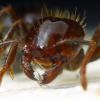Yesterday I bought a Drosophila hydei culture to supplement the diet of a few of my faster growing colonies. I know there are plenty of guides on how to setup a new culture, but I'm in a unique position and wanted to get opinions from people who have kept them before. After purchasing the culture yesterday, I realized that the company I work for makes their entire setup, save the fruit flies and the food medium. This means I can very easily get a hold of bits needed for new enclosures, and at whatever size I need at that. However I'm unsure of a couple of things:
-Are the store bought setups optimum?
-Is the plastic netting inside these setups ideal to provide surface area for the flies?
-Is there a point at which an enclosure is too small or too large?
-How long does the food medium stay good?
Any answers would be welcome.
















